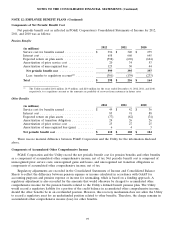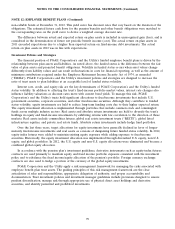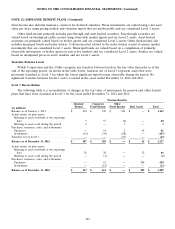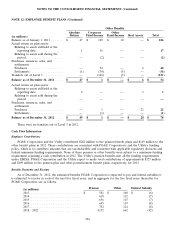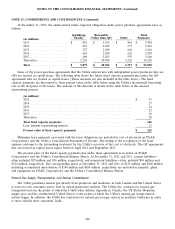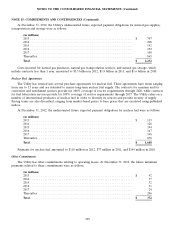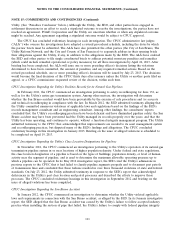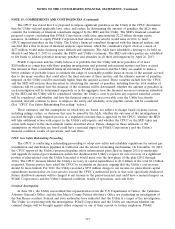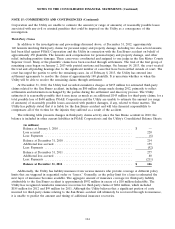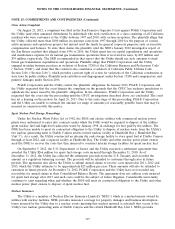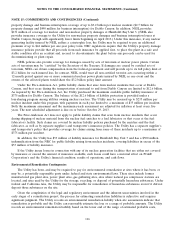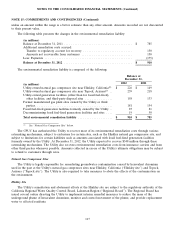PG&E 2012 Annual Report Download - page 111
Download and view the complete annual report
Please find page 111 of the 2012 PG&E annual report below. You can navigate through the pages in the report by either clicking on the pages listed below, or by using the keyword search tool below to find specific information within the annual report.
NOTES TO THE CONSOLIDATED FINANCIAL STATEMENTS (Continued)
NOTE 15: COMMITMENTS AND CONTINGENCIES (Continued)
Commitments
Third-Party Power Purchase Agreements
As part of the ordinary course of business, the Utility enters into various agreements to purchase power and
electric capacity. The price of purchased power may be fixed or variable. Variable pricing is generally based on the
current market price of either natural gas or electricity at the date of delivery.
The costs incurred for all power purchases were as follows:
2012 2011 2010
(in millions)
Qualifying facilities(1) ........................ $ 779 $ 1,069 $ 1,164
Renewable energy contracts ................... 815 622 573
Other power purchase agreements .............. 661 690 657
(1) Costs incurred include $286, $297, and $321 attributable to renewable energy contracts with qualifying facilities at December 31,
2012, 2011 and 2010, respectively.
Qualifying Facility Power Purchase Agreements—Under the Public Utility Regulatory Policies Act of 1978
(‘‘PURPA’’), electric utilities are required to purchase energy and capacity from independent power producers with
generation facilities that meet the statutory definition of a qualifying facility (‘‘QF’’). QFs include small power
production facilities whose primary energy sources are co-generation facilities that produce combined heat and power
and renewable generation facilities. To implement the purchase requirements of PURPA, the CPUC required
California investor-owned electric utilities to enter into long-term power purchase agreements with QFs and
approved the applicable terms and conditions, prices, and eligibility requirements. These agreements require the
Utility to pay for energy and capacity. Energy payments are based on the QF’s electrical output and CPUC-approved
energy prices. Capacity payments are based on the QF’s total available capacity and contractual capacity
commitment. Capacity payments may be adjusted if the QF exceeds or fails to meet performance requirements
specified in the applicable power purchase agreement.
As of December 31, 2012, the Utility had agreements with 180 QFs that are in operation, which expire at
various dates between 2013 and 2028.
Renewable Energy Power Purchase Agreements—The Utility has entered into various contracts to purchase
renewable energy to help the Utility meet California’s current renewable portfolio standard (‘‘RPS’’) requirement.
California’s RPS program gradually increases the amount of renewable energy that load-serving entities, such as the
Utility, must deliver to their customers from an average of at least 20% of their total retail sales in the years
2011-2013 to 33% of their total retail sales in 2021 and thereafter. Generally these agreements include an energy
payment based on the electrical output and a fixed price per Megawatt-hour. The Utility’s obligations under a
significant portion of these agreements are contingent on the third party’s construction of new generation facilities.
The table below includes arrangements that have been approved by the CPUC and have completed major milestones
with respect to construction. The Utility’s commitments for energy payments under these renewable energy
agreements are expected to grow significantly, assuming that the facilities are developed timely.
Other Power Purchase Agreements—The Utility has entered into several power purchase agreements for
conventional generation resources, which include tolling agreements and resource adequacy agreements. The Utility’s
obligation under a portion of these agreements is contingent on the third parties’ development of new generation
facilities to provide capacity and energy products to the Utility under tolling agreements. The Utility also has
agreements with various irrigation districts and water agencies to purchase hydroelectric power.
107


